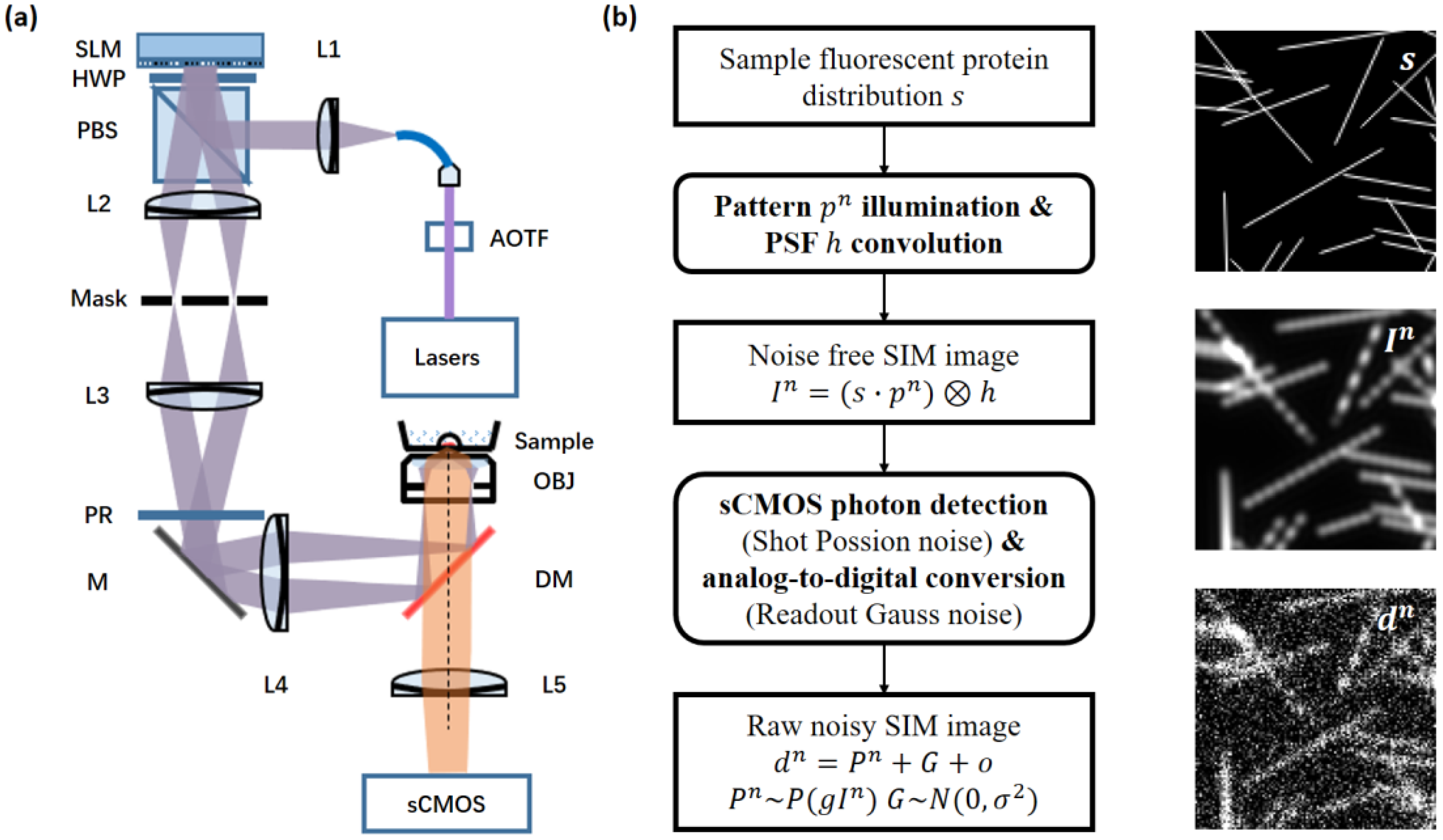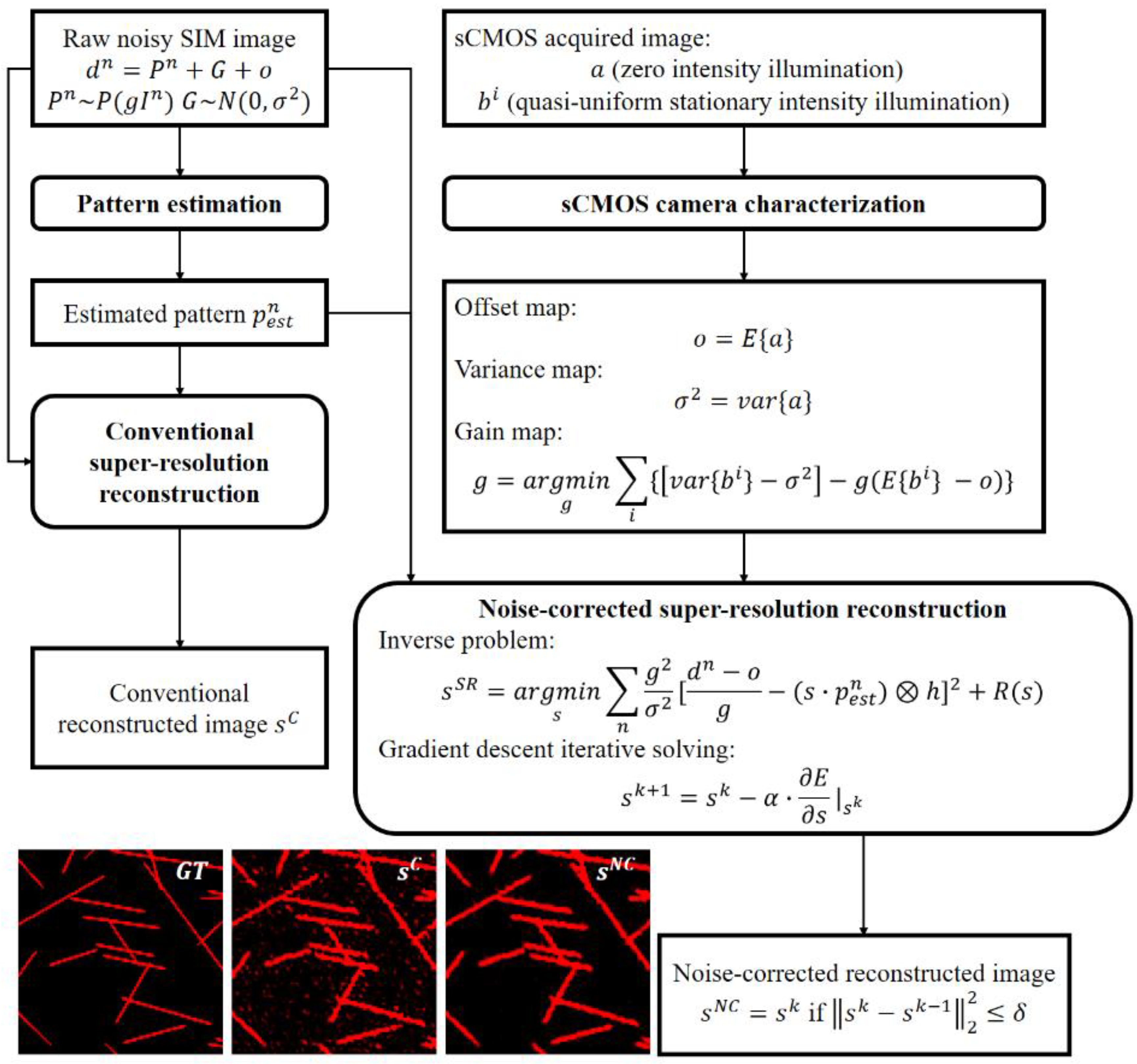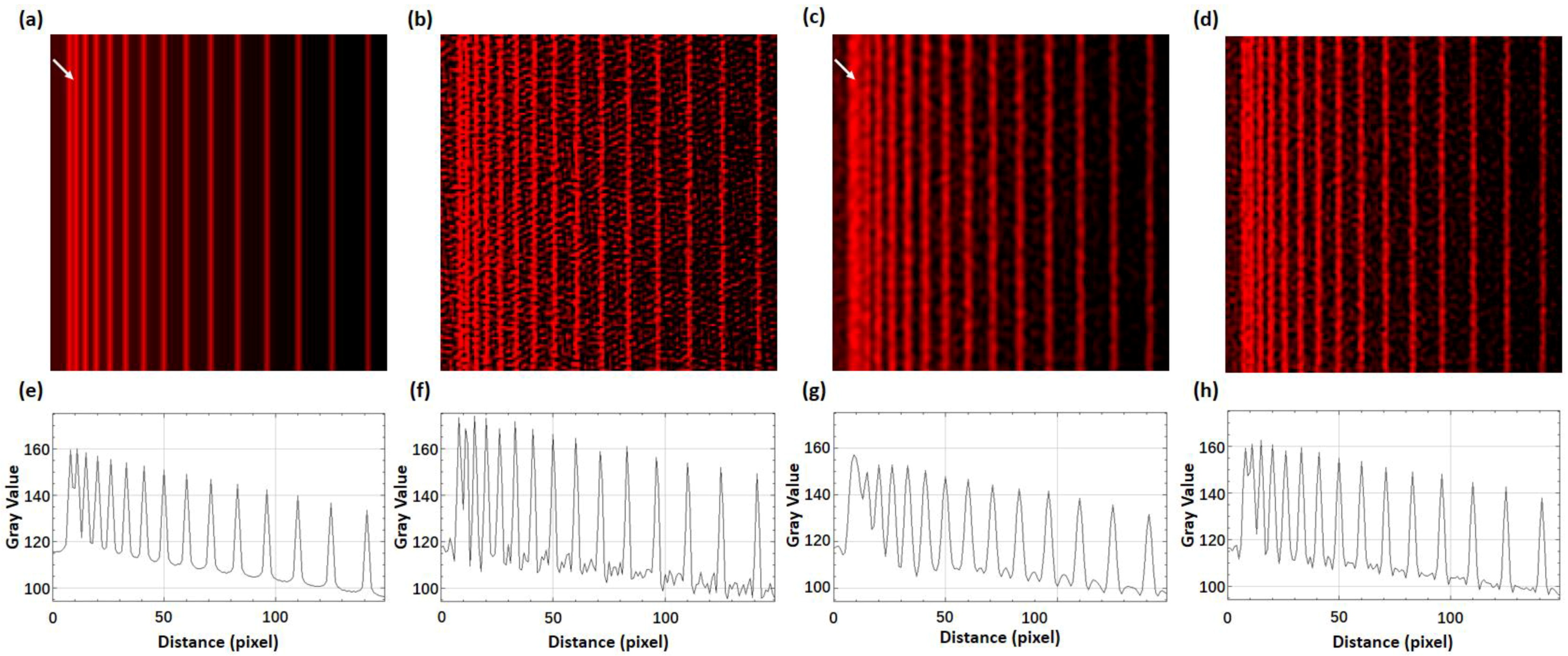sCMOS Noise-Corrected Superresolution Reconstruction Algorithm for Structured Illumination Microscopy
Abstract
:1. Introduction
2. Methods
2.1. SIM Imaging Model
2.2. sCMOS Camera Noise Model
2.3. sCMOS Camera Characterization
2.4. sCMOS Noise-Corrected SIM Reconstruction Algorithm
| Algorithm 1. Pseudocode of the Bi-CGSTAB algorithm. |
| Bi-CGSTAB algorithm |
| Input: ,
Initialization: , , , , Iteration: For , if Terminating. Else End Output: |
3. Results
4. Discussion
5. Conclusions
Author Contributions
Funding
Data Availability Statement
Conflicts of Interest
References
- Hell, S.; Wichmann, J. Breaking the Diffraction Resolution Limit by Stimulated-Emission: Stimulated-Emission-Depletion Fluorescence Microscopy. Opt. Lett. 1994, 19, 780–782. [Google Scholar] [CrossRef] [PubMed]
- Dyba, M.; Jakobs, S.; Hell, S. Immunofluorescence stimulated emission depletion microscopy. Nat. Biotechnol. 2003, 21, 1303–1304. [Google Scholar] [CrossRef] [PubMed]
- Gao, P.; Prunsche, B.; Zhou, L.; Nienhaus, K.; Nienhaus, G.U. Background suppression in fluorescence nanoscopy with stimulated emission double depletion. Nat. Photonics 2017, 11, 163–169. [Google Scholar] [CrossRef]
- Betzig, E.; Patterson, G.H.; Sougrat, R.; Lindwasser, O.W.; Olenych, S.; Bonifacino, J.S.; Davidson, M.W.; Lippincott-Schwartz, J.; Hess, H.F. Imaging Intracellular Fluorescent Proteins at Nanometer Resolution. Science 2006, 313, 1642–1645. [Google Scholar] [CrossRef] [PubMed] [Green Version]
- Hess, S.T.; Girirajan, T.P.K.; Mason, M.D. Ultra-high resolution imaging by fluorescence photoactivation localization microscopy. Biophys. J. 2006, 91, 4258–4272. [Google Scholar] [CrossRef] [PubMed] [Green Version]
- Errico, C.; Pierre, J.; Pezet, S.; Desailly, Y.; Lenkei, Z.; Couture, O.; Tanter, M. Ultrafast ultrasound localization microscopy for deep super-resolution vascular imaging. Nature 2015, 527, 499–502. [Google Scholar] [CrossRef]
- Huang, B.; Wang, W.; Bates, M.; Zhuang, X. Three-dimensional super-resolution imaging by stochastic optical reconstruction microscopy. Science 2008, 319, 810–813. [Google Scholar] [CrossRef] [Green Version]
- Linde, S.; Löschberger, A.; Klein, T.; Heidbreder, M.; Wolter, S.; Heilemann, M.; Sauer, M. Direct stochastic optical reconstruction microscopy with standard fluorescent probes. Nat. Protoc. 2011, 6, 991–1009. [Google Scholar] [CrossRef]
- Rust, M.J.; Bates, M.; Zhuang, X. Sub-diffraction-limit imaging by stochastic optical reconstruction microscopy (STORM). Nat. Methods 2006, 3, 793–795. [Google Scholar] [CrossRef] [Green Version]
- Gustafsson, M.G.L. Surpassing the lateral resolution limit by a factor of two using structured illumination microscopy. Short Commun. J. Microsc. 2000, 198, 82–87. [Google Scholar] [CrossRef] [Green Version]
- Cragg, G.E.; So, P. Lateral resolution enhancement with standing evanescent waves. Opt. Lett. 2000, 25, 46–48. [Google Scholar] [CrossRef] [PubMed]
- Frohn, J.T.; Knapp, H.F.; Stemmer, A. True optical resolution beyond the Rayleigh limit achieved by standing wave illumination. Proc. Natl. Acad. Sci. USA 2000, 97, 7232–7236. [Google Scholar] [CrossRef] [PubMed] [Green Version]
- Günther, B.; Hehn, L.; Jud, C.; Hipp, A.; Dierolf, M.; Pfeiffer, F. Full-field structured-illumination super-resolution X-ray transmission microscopy. Nat. Commun. 2019, 10, 2494. [Google Scholar] [CrossRef] [PubMed] [Green Version]
- York, A.; Parekh, S.; Nogare, D.; Fischer, R.; Temprine, K.; Mione, M.; Chitnis, A.; Combs, C.; Shroff, H. Resolution doubling in live, multicellular organisms via multifocal structured illumination microscopy. Nat. Methods 2012, 9, 749–754. [Google Scholar] [CrossRef]
- Mudry, E.; Belkebir, K.; Girard, J.; Savatier, J.; Le Moal, E.; Nicoletti, C.; Allain, M.; Sentenac, A. Structured illumination microscopy using unknown speckle patterns. Nat. Photonics 2012, 6, 312–315. [Google Scholar] [CrossRef]
- Kner, P.; Chhun, B.B.; Griffis, E.R.; Winoto, L.; Gustafsson, M.G.L. Super-resolution video microscopy of live cells by structured illumination. Nat. Methods 2009, 6, 339–342. [Google Scholar] [CrossRef] [Green Version]
- Shao, L.; Kner, P.; Rego, E.H.; Gustafsson, M.G.L. Super-resolution 3D microscopy of live whole cells using structured illumination. Nat. Methods 2011, 12, 1044–1046. [Google Scholar] [CrossRef]
- Fiolka, R.; Shao, L.; Rego, E.H.; Davidson, M.W.; Gustafsson, M.G.L. Time-lapse two-color 3D imaging of live cells with doubled resolution using structured illumination. Proc. Natl. Acad. Sci. USA 2012, 109, 5311–5315. [Google Scholar] [CrossRef] [Green Version]
- Diekmann, R.; Till, K.; Müller, M.; Simonis, M.; Schüttpelz, M.; Huser, T. Characterization of an industry-grade CMOS camera well suited for single molecule localization microscopy-high performance super-resolution at low cost. Sci. Rep. 2017, 7, 14425. [Google Scholar] [CrossRef]
- Lin, R.; Clowsley, A.H.; Jayasinghe, I.D.; Baddeley, D.; Soeller, C. Algorithmic corrections for localization microscopy with sCMOS cameras-characterisation of a computationally efficient localization approach. Opt. Express 2017, 25, 11701–11716. [Google Scholar] [CrossRef] [Green Version]
- Zhang, Z.; Wang, Y.; Piestun, R.; Huang, Z. Characterizing and correcting camera noise in back-illuminated sCMOS cameras. Opt. Express 2021, 29, 6668–6690. [Google Scholar] [CrossRef] [PubMed]
- Saurabh, S.; Maji, S.; Bruchez, M.P. Evaluation of sCMOS cameras for detection and localization of single Cy5 molecules. Opt. Express 2012, 20, 7338–7349. [Google Scholar] [CrossRef] [PubMed]
- Huang, X.; Fan, J.; Li, L.; Liu, H.; Wu, R.; Wu, Y.; Wei, L.; Mao, H.; Lal, A.; Xi, P.; et al. Fast, long-term, super-resolution imaging with Hessian structured illumination microscopy. Nat. Biotechnol. 2018, 36, 451–459. [Google Scholar] [CrossRef] [PubMed]
- Huang, F.; Hartwich, T.; Rivera-Molina, F.; Lin, Y.; Duim, W.; Long, J.; Uchil, P.; Myers, J.; Baird, M.; Mothes, W.; et al. Video-rate nanoscopy using sCMOS camera-specific single-molecule localization algorithms. Nat. Methods 2013, 10, 653–658. [Google Scholar] [CrossRef]
- Liu, S.; Mlodzianoski, M.; Hu, Z.; Ren, Y.; McElmurry, K.; Suter, D.; Huang, F. sCMOS noise-correction algorithm for microscopy images. Nat. Methods 2017, 14, 760–761. [Google Scholar] [CrossRef]
- Mandracchia, B.; Hua, X.; Guo, C.; Son, J.; Urner, T.; Jia, S. Fast and accurate sCMOS noise correction for fluorescence microscopy. Nat. Commun. 2020, 11, 94. [Google Scholar] [CrossRef] [Green Version]
- Xue, F.; He, W.; Xu, F.; Zhang, M.; Chen, L.; Xu, P. Hessian single-molecule localization microscopy using sCMOS camera. Biophys. Rep. 2018, 4, 215–221. [Google Scholar] [CrossRef]
- Li, L.; Li, M.; Zhang, Z.; Huang, Z. Assessing low-light cameras with photon transfer curve method. J. Innov. Opt. Health Sci. 2016, 9, 1630008. [Google Scholar] [CrossRef] [Green Version]
- van der Vorst, H.A. Bi-CGSTAB: A Fast and Smoothly Converging Variant of Bi-CG for the Solution of Nonsymmetric Linear Systems. Siam J. Sci. Stat. Comput. 1992, 13, 631–644. [Google Scholar] [CrossRef]
- Abascal, P.; Chamorro-Servent, J.; Aguirre, J. Fluorescence diffuse optical tomography using the split Bregman method. Med. Phys. 2011, 38, 6275–6284. [Google Scholar] [CrossRef] [Green Version]




| Shot Noise Level | Readout Noise Level | SNR | |
|---|---|---|---|
| Conventional | Noise-Corrected | ||
| 100 | 10 | 11.167 | 13.349 |
| 20 | 10.336 | 12.942 | |
| 30 | 9.627 | 12.521 | |
| 150 | 10 | 12.280 | 14.338 |
| 20 | 11.432 | 13.865 | |
| 30 | 10.852 | 13.496 | |
| 200 | 10 | 11.149 | 13.363 |
| 20 | 8.734 | 10.562 | |
| 30 | 5.294 | 6.460 | |
Publisher’s Note: MDPI stays neutral with regard to jurisdictional claims in published maps and institutional affiliations. |
© 2022 by the authors. Licensee MDPI, Basel, Switzerland. This article is an open access article distributed under the terms and conditions of the Creative Commons Attribution (CC BY) license (https://creativecommons.org/licenses/by/4.0/).
Share and Cite
Zhou, B.; Huang, X.; Fan, J.; Chen, L. sCMOS Noise-Corrected Superresolution Reconstruction Algorithm for Structured Illumination Microscopy. Photonics 2022, 9, 172. https://doi.org/10.3390/photonics9030172
Zhou B, Huang X, Fan J, Chen L. sCMOS Noise-Corrected Superresolution Reconstruction Algorithm for Structured Illumination Microscopy. Photonics. 2022; 9(3):172. https://doi.org/10.3390/photonics9030172
Chicago/Turabian StyleZhou, Bo, Xiaoshuai Huang, Junchao Fan, and Liangyi Chen. 2022. "sCMOS Noise-Corrected Superresolution Reconstruction Algorithm for Structured Illumination Microscopy" Photonics 9, no. 3: 172. https://doi.org/10.3390/photonics9030172
APA StyleZhou, B., Huang, X., Fan, J., & Chen, L. (2022). sCMOS Noise-Corrected Superresolution Reconstruction Algorithm for Structured Illumination Microscopy. Photonics, 9(3), 172. https://doi.org/10.3390/photonics9030172





